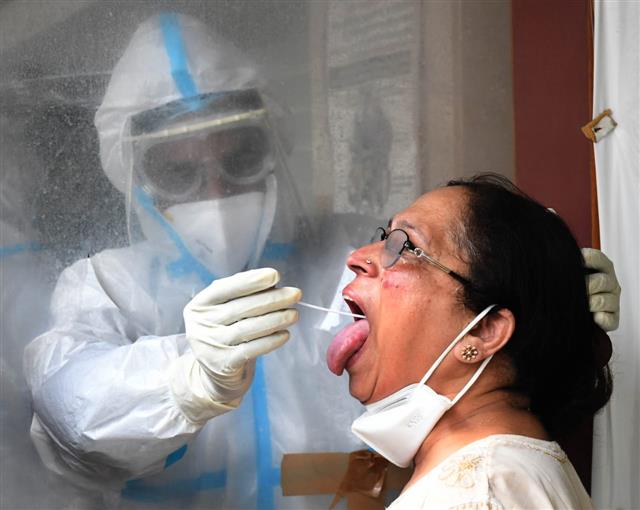
A medic collects a sample of a woman for COVID-19 testing, during the ongoing nationwide lockdown, in New Delhi, Saturday, June 13, 2020. Tribune Photo: Mukesh Aggarwal
Aditi Tandon
Tribune News Service
New Delhi, June 13
With COVID-19 cases crossing the 3 lakh mark on Monday, India expanded the list of symptoms which people should watch out for in order to report the infection.
Based on evidence from other countries, the Ministry of Health today included muscle pain, mucous formation in throat, clogged nasal cavity, sore throat, diarrhoea and loss of taste and smell as new COVID symptoms apart from the previous three signs of fever, short breath and cough.
Symptom check
Common symptoms
- Fever
- Breathlessness
- Cough
Other Symptoms
- Fatigue
- Muscle pain
- Mucous formatiion
-
Clogged nasal cavity
- Sore throat
- Diarrhoea
- Loss of taste (anosmia).
- Loss of smell (ageusia)
The government’s clinical protocol on COVID19 released today says loss of smell (anosmia) or loss of taste (ageusia) preceding the onset of respiratory symptoms could be one of the signs of the disease.
People over 60 and those with non-communicable diseases----diabetes, hypertension, cardiac disease, chronic lung disease, cerebro-vascular disease, chronic kidney disease, immune-suppression and cancer---are among the high risk category, said the Ministry.
Current disease data from the Ministry shows non-specific and varied symptoms in people. A study on 15,366 COVID patients recently showed the presence of fever in 27%, cough (21%), sore throat (10%), breathlessness (8%), Weakness (7%), running nose (3%) and other symptoms 24%.
The Ministry said current available evidence for COVID-19 suggests that the causative virus (SARS-CoV-2) has a zoonotic source closely related to bat-origin SARS-like coronavirus and the persons infected by the novel coronavirus are the main source of infection through close contact mainly respiratory droplets released when the infected person coughs, sneezes, or talks.
These droplets may land on surfaces, where the virus remains viable and infection occur if a person touches an infected surface and then touches his or her eyes, nose, or mouth.
“The median incubation period is 5.1 days (range 2–14 days). As per the current evidence, the period of infectivity starts 2 days prior to onset of symptoms and lasts up to 8 days,” protocols say adding that the role of asymptomatic people in transmitting the virus remains under probe.
The Ministry also admits that while most patients with COVID-19 predominantly have a respiratory tract infection associated with SARS-CoV-2 infection, some can progress to a
Severe Acute Respiratory Distress Syndrome (ARDS), sepsis and septic shock, multi-organ failure, including acute kidney injury and cardiac injury.
The government has defined a suspected case as a patient with acute respiratory illness (fever and at least one sign/symptom of respiratory disease, e.g., cough, shortness of breath), and a history of travel to or residence in a location reporting community transmission of COVID-19 disease during the 14 days prior to symptom onset; or a patient with any acute respiratory illness and having been in contact with a confirmed or probable COVID-19 case in the last 14 days prior to symptom onset; or a patient with severe acute respiratory illness (fever and at least one sign/symptom of respiratory disease, e.g., cough, shortness of breath and requiring hospitalisation).
The government said on Friday that anti-viral drug Remdisivir (under trial in other countries) can be used in emergencies in patients with moderate disease (those on oxygen) but not in those with renal complication, pregnant and lactating women and children under 12.
Convalescent plasma has been allowed in patients with moderate disease who are not improving (oxygen requirement is progressively increasing) despite use of steroids.
Tocilizumab medicine can be considered in patients with moderate disease with progressively increasing oxygen requirements and in mechanically ventilated patients not improving despite use of steroids, the protocols say adding that those on Tocilizumab should be reviewed for secondary infections. This medicine should not be given to people with TB.
Join Whatsapp Channel of The Tribune for latest updates.


























